50 SEO Statistics & Trends To Improve Your 2024 Strategy
Curious about the state of SEO?
SEO is one of the fastest-changing branches of digital marketing. Every year, Google releases several major updates that completely change the playing field.
In this post, I’ve compiled 50 of the latest SEO statistics and trends that you need to know.
These stats tell you more about the current state of SEO and where it’s heading. You’ll find useful insights relating to search trends, ranking factors, and other best practices to improve your strategy.
General SEO statistics
First, let’s start with some of the most important SEO statistics for marketers, agencies, and businesses.
1. 53% of all trackable website traffic comes from organic search
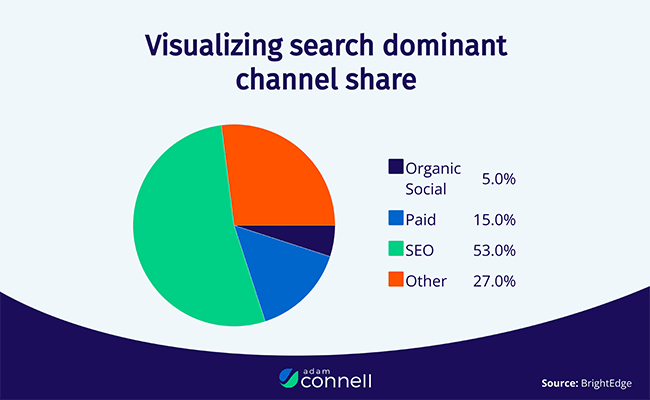
As this stat shows, organic search is still the best source of inbound website traffic and drives more than paid search, social media, and other marketing channels combined. No wonder so many businesses continue to invest heavily in SEO.
Source: BrightEdge
2. Leads generated through SEO have a close rate of 14.6%
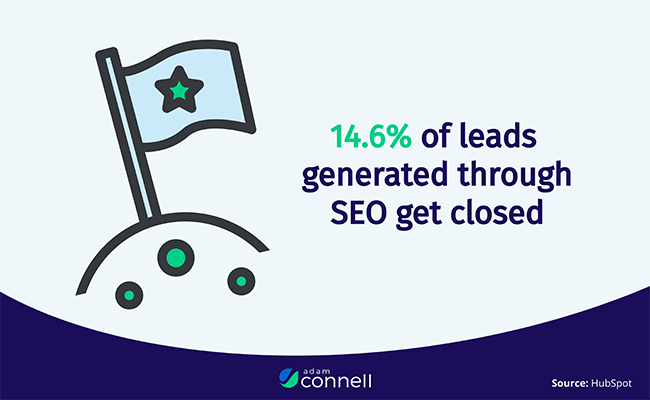
One criticism you often hear about SEO is that businesses that focus exclusively on ranking to increase organic traffic end up with low-quality traffic that isn’t qualified. However, as this stat shows, the truth is that SEO can be a great source of high-quality leads that convert to paying customers.
Source: HubSpot2
3. 35.1% of marketers dedicate a ‘moderate’ chunk of their budget to SEO

This is according to a recent survey. The survey also found that another quarter spends ‘most’ of their digital marketing budget on SEO, making it one of the top marketing activities by spend. Meanwhile, digital PR is the activity that’s least likely to receive a substantial budget allocation.
Source: Search Engine Journal1
4. 43.9% of marketers look at keyword rankings to measure SEO success

Keyword rankings are the most important performance indicator when it comes to SEO, according to almost half of all survey respondents. Page views ranked as the second most popular KPI, with 32.8% of marketers using it as a measure of success.
Comparatively, only 19.9% look at conversions to measure the success of their SEO campaigns, making the metric half as likely to be used as keyword rankings.
Source: Search Engine Journal1
5. Most SEO professionals earn $50-$74k per year
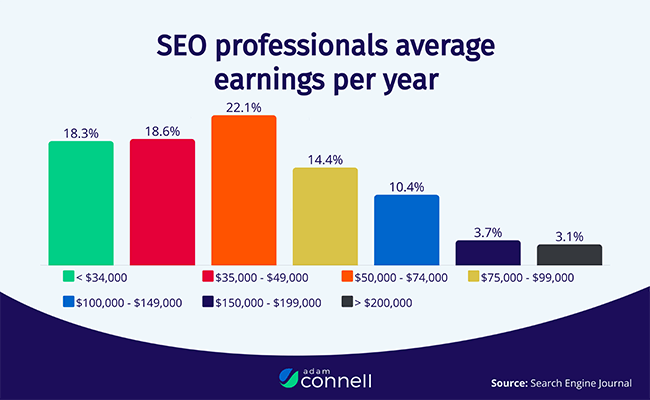
…but the top-earners can command salaries of over $200,000. Amongst these high earners, 17% have over 20 years of experience in the industry.
Source: Search Engine Journal1
6. Businesses spend $1,000-$5,000 per month on SEO services, on average
If you’re a freelance SEO marketer or running an agency, this is roughly how much you should expect to earn from your clients.
Source: Search Engine Journal1
7. 38% of SEO clients think it’s an essential part of marketing
And they’re not wrong! But of course, whether or not SEO should have a place in your marketing strategy will depend on the nature of your business.
Source: Search Engine Journal1
8. Content strategy is the most in-demand service from SEO clients
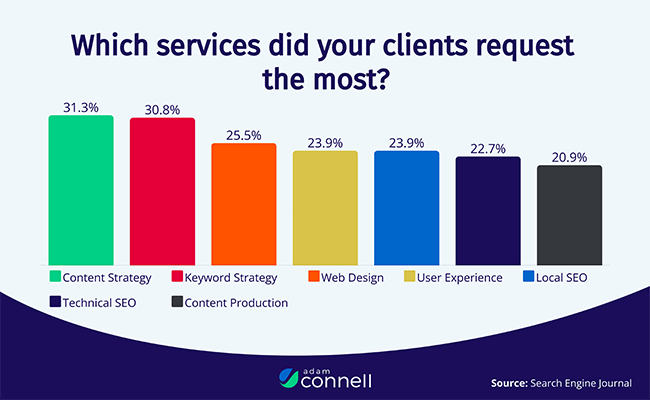
31.3% of SEO agencies and freelancers said their clients requested this service the most. Keyword strategy services came second (30.8%). Interestingly, content production services came a distant seventh (20.9%).
Source: Search Engine Journal1
Search engine statistics
Next, let’s learn a little more about the search engines we’re optimizing for. Here are a handful of search engine statistics you might find interesting.
9. Over two-thirds of online experiences start with a search engine
68%. That’s how many online experiences begin with a search.
Source: BrightEdge
10. Over 90% of web search traffic happens on Google
It probably won’t come as a surprise to hear that Google has a near-monopoly on search traffic. Over 90% of web search traffic happens on the search engine giant, spread over Google Search, Google Images, and Google Maps.
Source: Sparktoro
11. It’s estimated that there are over 5.6 billion Google searches per day
To put that into perspective, there are only 7.75 billion people on earth. That’s right—the number of searches Google processes every single day is equal to over 70% of all humans on the planet. That’s a lot.
Source: HubSpot1
12. Bing is the second most popular web search engine with 2.27% of the market share
Google is, of course, the runaway winner with over 92% of the market share—but you already knew that. Amongst those trailing far behind, Bing leads the pack, albeit with a measly 2.27% of the market share. Yahoo (1.53%) and Baidu (1.45%) come third and fourth, respectively.
Source: Statcounter
13. 49% of all online shopping searches begin on Amazon
Google might dominate the general search market, but when looking for products to buy, most consumers will start their search on ecommerce giant Amazon. If you’re selling products online, you’ll want to optimize for product searches on both Amazon and Google to maximize your reach.
Source: eMarketer
SERP / ranking statistics
SERP stands for Search Engine Results Pages. The stats below tell us more about the kind of pages that typically rank in the SERPs, and how ranking position affects organic traffic.
14. Over a quarter of clicks go to the top-ranking result on Google
The average click-through rate (CTR) of the first result is 28.5%, according to a recent analysis of billions of search results. That means that over a quarter of people who search for a query will end up clicking on the top-ranked page.
The upshot of this is clear: If you want to maximize your clicks, you should be aiming to rank in the top spot.
However, ranking in first place isn’t easy, especially for competitive keywords. Failing that, you’ll want to at least rank on the first page, as close to the top as possible. The top three results combined account for over 50% of all clicks.
Source: Search Engine Journal2
15. Less than 1% of searchers click on 2nd-page results
It’s often said that websites that fail to rank on the first page of Google are pretty much invisible—and this stat proves it. The vast majority of searchers won’t bother to click through to page two, so try to make sure your content is visible on the first page.
Source: Backlinko1
16. Google Ads reduce the CTR of the top-ranking organic results by around 10%
Remember how we said the CTR for the first SERP result was over 28%? Well, that’s assuming all the results are organic. If Google loads the top of the results page with paid ads, they’ll steal a bunch of your clicks.
In fact, the average CTR for the first result drops to just over 18% when Google Ads are present! Bad news for SEO marketers; good news PPC marketers.
Source: Search Engine Journal2
17. Top-ranking pages in results with knowledge panels get 12% fewer clicks
Just as with paid ads, CTR takes a hit when organic results appear alongside knowledge panels. Without knowledge panels, the first page in the organic search results gets a CTR of over 28%. With knowledge panels, that drops to just 16%.
If you didn’t already know, knowledge panels are a type of ‘rich results’ that sometimes appear on the search results pages in Google for specific queries. They’re informational boxes that appear above the organic listings and automatically take useful information about the searcher’s query from web pages and display it on the results page.
The reason they negatively impact clicks is that users can often see the information they need in the knowledge boxes, without having to click through to the actual web page. Many marketers have voiced frustration at the feature as it essentially ‘steals’ clicks from websites in order to improve Google’s user experience.
Source: Search Engine Journal2
18. The average top-ranking page is over 2 years old
…which goes against the oft-said theory that fresh content ranks better. However, it supports the idea that SEO is a long-term strategy. It can take years before you start seeing results from your SEO efforts.
Source: Ahrefs4
19. Over a quarter of top-ranking pages don’t have meta descriptions
Of those that do, over 40% have meta descriptions that truncate. And what’s more Google only shows meta descriptions around 37% of the time. The takeaway: meta descriptions aren’t all that important (but probably still worth using).
Source: Ahrefs3
20. 32.8% of SEO experts think on-page elements are the most important ranking factors
On-page ranking factors include things like headlines, images, alt text, title tags, meta descriptions, and the content itself. Nearly a third of SEO professionals think these types of factors have the biggest impact on ranking potential.
Source: Search Engine Journal3
Link building statistics
Link building is one of the most important parts of off-site SEO. It involves taking steps to get other authoritative and relevant websites to link back to your domain in order to increase your perceived domain authority and ranking potential. Here are some link-building stats you should know.
21. The top-ranking results on Google have 3.8x more backlinks
Many studies have found a correlation between backlinks and organic ranking positions. The most straightforward conclusion we can draw from this is that the more backlinks you have, the better chance you have of ranking above your competitors in the SERPs.
However, it’s not quite that simple. Remember: it’s not just about quantity—quality matters too.
For backlinks to be effective, they need to be high-quality and relevant to your niche. Building hundreds of low-quality links on irrelevant sites or in bad neighborhoods can actually hurt your SEO and land you Google penalties. Focus your efforts on earning great, editorially-placed links and you’ll see better results.
Source: Backlinko2
22. Around two-thirds of pages on the internet have no backlinks
Despite the clear importance of backlinks, the majority of pages on the internet don’t have any! While shocking, this also means that you can easily rise above the bulk of the search competition by spending some time on link-building campaigns.

Source: Ahrefs1
23. SEO professionals spend the least amount of time on off-page SEO (link building)
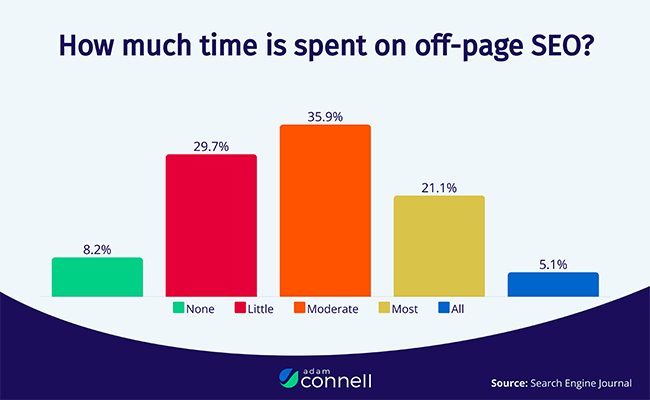
Interestingly, off-page SEO activities like link building received the lowest time allocation from SEO professionals, on average. Despite its importance, 29.7% of SEOs said they spent little time on off-page activities, and 8.2% spent no time on link building at all.
Source: Search Engine Journal3
24. The average paid backlink costs around $360

The best way to get high-quality backlinks is to earn them by creating content that’s worth linking to. However, many businesses opt to buy their backlinks instead. These links can cost hundreds of dollars each, making it a very costly endeavor. Meanwhile, paid guest posts costs around $77.80.
But buying links isn’t just costly, it’s also a risky practice. It may be considered a black hat SEO tactic as it goes against Google’s webmaster guidelines. If you go down this route, make sure you’re aware of the risks. You don’t want to incur the wrath of Google and wind up with penalties that negatively impact your SEO.
Source: Ahrefs5
Note: You can find more in my article on link building statistics.
Local SEO statistics
Next, let’s take a look at some local SEO statistics.
25. 30% of all searches on mobile are related to location
Data from Google tells us that almost a third of all queries on mobile devices are location-related. If you’re running a physical store, optimizing your online presence for mobile search is essential.
Source: Think With Google2
26. 76% of mobile users who search for local businesses visit one within 24 hours

And that’s precisely why local SEO is so important for local businesses. Ensuring you rank for those mobile search queries translates to more foot traffic to your physical store.
Source: Think With Google1
27. Yelp ranks in the top 5 SERP results for 92% of local search queries
Here, we’re defining local search queries as web queries that include a city and business category. The takeaway from this stat is to make sure your business is listed on Yelp, as well as other directory sites that have plenty of ranking power.
Source: FreshChalk
28. Mobile search queries containing “where to buy” & “near me” doubled in two years
Between 2017 and 2019, these types of local search queries grew by 200%.
Source: Think With Google3
Mobile SEO statistics
Ever wondered how much search traffic comes through mobile devices compared to desktops? Let’s find out.
29. Over half of all website traffic globally comes from mobile

54.4%, to be exact. This is dramatically higher than it was back in 2015, at which point the share of mobile traffic was responsible for less than a third of total web traffic (31%). This increase in mobile website traffic reflects a wider shift in consumer habits and the growth of ‘mobile-first’ economies.
Source: Statista
30. Top-ranking mobile search results get more clicks than desktop
Interestingly, the first page ranking in the results pages of mobile searches commands a greater share of clicks than on desktop searches. On mobile, the first search result gets an average CTR of 27.7%. On desktop, that drops to 19.3%
The reason for this may be related to screen size. More search results are visible above the fold on the larger screen of a laptop or desktop computer compared to mobile, which gives search users more options to click without having to scroll.
Source: SEOClarity
31. 51% of smartphone users discover new products and companies through mobile search
Again, this is according to data gathered by Google and shows how investing in mobile SEO can be a great way to improve your brand recognition and sell more products.
Source: Think With Google4
Video SEO statistics
When we think of SEO, we usually think about ranking posts and pages in Google. But let’s not forget that SEO is relevant to video content too. Here are some video SEO stats that tell us more about how to rank your content on video search engines like YouTube.
32. Engagement metrics correlate strongly with higher YouTube rankings

By engagement metrics, we’re talking about things like likes, comments, views, and shares. The more engagement your YouTube content generates, the better your chances of ranking at the top of the results.
Source: Backlinko4
33. 68.2% of videos that rank on page one of YouTube SERPs are HD

HD quality seems to be an important ranking factor, so if you’re still posting content in 480p, now might be the time to make a change and start publishing videos in high resolution.
Source: Backlinko4
34. The average top-ranking YouTube video is around 15 minutes long
14 minutes and 50 seconds, to be exact. That’s the ballpark you should be aiming for if you’re hoping to rank in the YouTube SERPs.
However, don’t forget that watch time is important too. There’s no point in creating longer videos if viewers click away after a few minutes, so make sure you create engaging content that keeps them gripped for the whole video.
Source: Backlinko4
Keyword statistics
All effective SEO campaigns start with careful keyword research. Here are some enlightening SEO statistics related to keywords.
35. SEO professionals spend most of their time on keyword research
36.3% of SEO experts in Search Engine Journal’s State of SEO report 2021 said they allocated most of their time to keyword research, making it the top SEO activity by time allocation. On-page SEO ranked second, with 33.4% of respondents saying they spend most of their time on on-page SEO tasks.
Source: Search Engine Journal3
36. Around 70% of search queries contain four or more words…
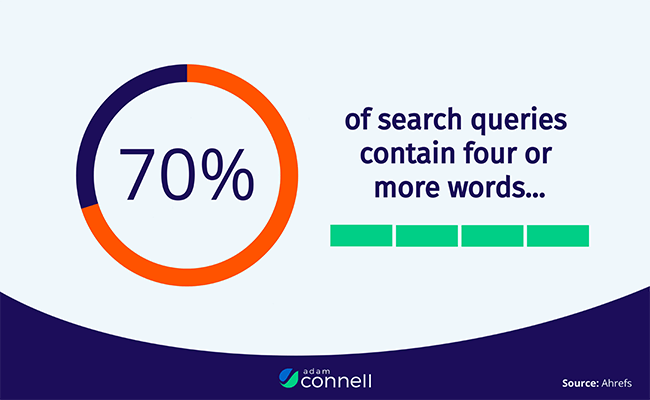
As this stat shows, long-tail keywords make up a significant chunk of total search traffic.
Source: Ahrefs2
37. …but 70% of those with 10k+ searches have just one or two words
Despite the high number of long-tail search queries, shorter keywords still tend to have much higher search volumes. It’s a good idea to target a mix of both short and long keyword phrases in your SEO strategy.
Source: Ahrefs2
38. Over 94% of keywords get ten or fewer monthly searches
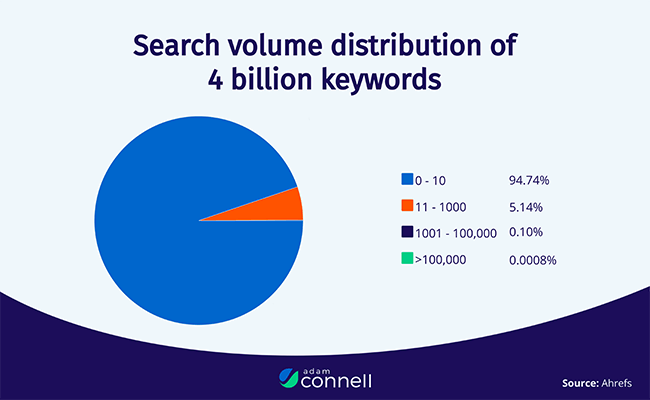
Meanwhile, the most popular 0.16% keywords are responsible for over 60% of searches each month. This shows that not all keywords are made equal—the vast majority of search traffic comes from a small fraction of them.
Source: Ahrefs2
39. Approximately 8% of keyword queries are phrased as questions
As more consumers have begun to use voice search, conversational search queries have become more popular. These types of queries are often phrased as questions and include words like ‘what’, ‘how’, and ‘where’.
Source: Moz
SEO trends
Next, let’s take a look at some SEO trends to uncover emerging strategies and ranking factors, and to find out where the industry is heading from here on out.
40. Almost 65% of SEOs think their results improved in 2021
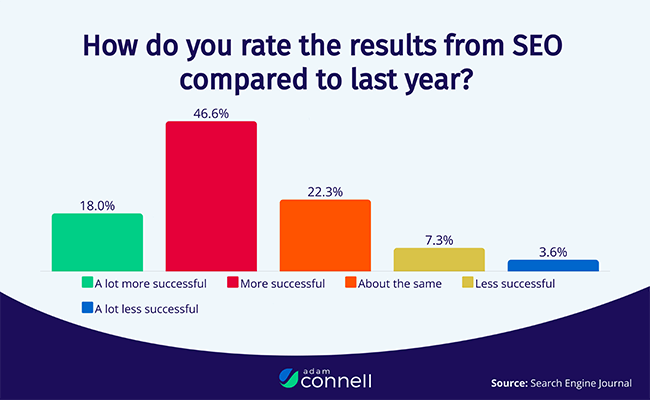
Last year seems to have been a strong one for the SEO industry, with more than two-thirds of SEO professionals rating their results as more successful than the previous period. This is likely because the pandemic caused the world to move online, with the global population spending more time searching the web.
Source: Search Engine Journal3
41. 36.7% of SEOs think Core Web Vitals are the most important emerging ranking factor
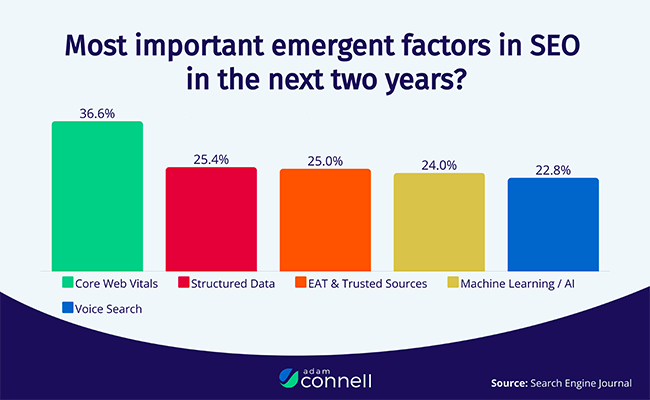
…and estimate that they will be for the next few years. In case you missed the memo, Core Web Vitals are a new set of metrics that Google uses to better understand how users experience your web page.
They measure things like how fast your page loads and how stable the layout is and have been increasingly important since Google started rolling out its page experience algorithm date last year.
Source: Search Engine Journal3
42. 34.7% of SEOs will focus on improving user experience this year
In light of the page experience update to Google’s algorithm and the upshot it has had on SEO ranking factors, it’s no surprise that over a third of SEOs are planning on spending more time improving the user experience of their websites.
Source: Search Engine Journal3
43. 25.4% of SEO pros identified structured data as another important emerging factor
Structured data, also known as Schema markup, is a way to help search engines like Google to better understand what your website content is about. Over a quarter of SEOs think it’s going to be an increasingly important ranking factor.
Source: Search Engine Journal3
44. 31% of SEOs think organic user behavior is the most important ranking factor
Organic user behavior includes things like CTR, bounce rate, and time on site. You can improve your bounce rate and time on site by creating captivating, useful content that readers won’t want to click away from.
Source: Search Engine Journal3
45. Nearly half of all consumers now use voice search for general web queries
…And over 40% of answers to those queries come from the featured snippet. If you’re not already factoring voice search into your SEO strategy, you should be.
Source: Search Engine Land and Backlinko3
SEO challenges
Finally, let’s take a look at some statistics that highlight the major challenges SEOs face this year.
46. Over 90% of pages get no organic search traffic from Google

As this stat shows, many websites are still failing to implement effective SEO as the vast majority fail to generate any organic traffic.
Source: Ahrefs1
47. Budget cuts were the biggest SEO challenge last year

SEO professionals who responded to a recent survey rated budget cuts as their biggest challenge. Many of these budget cuts came in the wake of the pandemic, as businesses were forced to reduce their spending on marketing as a way to keep costs down.
Source: Search Engine Journal3
48. 32.9% of SEOs rate lack of resources as their top challenge
That includes human resources. Many respondents in the survey reported finding it hard to find and attract new talent—there’s a huge demand for SEO services and a shortage of SEO professionals with the skills and knowledge necessary to meet that demand.
Source: Search Engine Journal3
49. 38.7% of SEOs say the industry’s biggest threat is zero-click SERPs
Rich snippets have been increasingly taking away clicks from website pages by providing answers to user queries within the SERPs, much to the displeasure of SEOs everywhere.
Source: Search Engine Journal3
50. 35.1% of SEOs say Google updates are their biggest concern
This is nothing new. SEO professionals constantly have to contend with new algorithm updates that change how Google ranks content, so it’s not surprising that this remains the major concern for over a third of respondents.
Source: Search Engine Journal3
Sources
Final thoughts
There you have it—50 SEO statistics to apply to your strategy this year. I hope you found these stats useful, or at least somewhat interesting!
Want more data? Check out these stats roundups:
